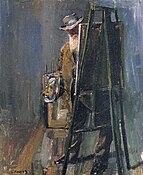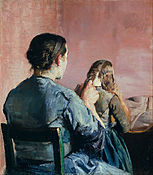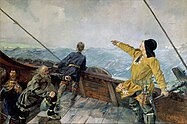Christian Krohg
Christian Krohg | |
|---|---|
 Krohg,c. 1903 | |
| Born | 13 August 1852 Vestre Aker,Norway |
| Died | 16 October 1925(aged 73) Christiania,Norway |
| Nationality | Norwegian |
| Alma mater | University of Christiana |
| Known for | naturalistpainter |
| Movement | Naturalism |
| Spouse | |
| Children | 2 (includingPer) |

Oda Krohg (c. 1903)

Christian Krohg(13 August 1852 – 16 October 1925) was a Norwegiannaturalistpainter, illustrator, author and journalist. Krohg was inspired by therealism art movementand often chose motifs from everyday life. He was the director and served as the first professor at theNorwegian Academy of Artsfrom 1909 to 1925.[1][2]
Biography
[edit]Christian Krohg was born atVestre Aker(now Oslo), Norway. He was one of five children born to Georg Anton Krohg (1817–1873) and Sophie Amalia Holst (1822–1861). He was a grandson ofChristian Krohg(1777–1828) who had served as a government minister. His father was a civil servant, journalist and author. His mother died when he was only 8 years old, and his father's sister took over responsibility for the household and the upbringing of the children. From 1861, he attendedHartvig Nissen School.[citation needed]
His father had asked him to pursue a legal career. Krohg studied law at theUniversity of Oslo(thenChristiania) graduatingcand.jur.in 1873, the same year in which his father died. During 1869–70, he had also studied at the art school ofJohan Fredrik EckersbergatLille Grensenin Christiania. He was additionally educated in Germany, first at theBaden School of ArtinKarlsruheunderHans Gudein 1874. He also trained underKarl Gussowfrom 1875. He followed with study at theKönigliche AkademieinBerlinfrom 1875 to 1878.[3]
He was awarded the Schäffer's legacy (1876–77) and received a government travel allowance during 1877–78 and in 1881. In 1879, on the encouragement of artistFrits Thaulow,he visited theSkagen artists colony.He returned toSkagenin 1882–84 and 1888. Through his periodic future residence at Skagen, he would influence other artists includingAnnaandMichael Ancherand provided early support toEdvard Munch.[4]
Krohg worked inParisfrom 1881 to 1882. Inspired by the ideas of therealistshe chose motifs primarily from everyday life – often its darker or socially inferior sides. Prostitution is the subject of his paintingAlbertine i politilægens venteværelse,and Krohg also wrote a novel about the depicted scene. The novel,Albertine,caused a scandal when first published, and it was confiscated by the police.[citation needed]
Krohg's style made him a leading figure in the transition fromromanticismtonaturalism.[3]
Krohg was the founding and editor-in-chief of theKristiania Bohemianjournal,Impressionistenfrom 1886 until 1890. He then became a journalist for theOslonewspaperVerdens Gangfrom 1890 to 1910. Christian Krohg was also associated withPolitiken1893–1894.
He taught atAcadémie Colarossiin Paris from 1902 until 1909. Later he became a professor-director at theNorwegian Academy of Arts(Statens Kunstakademi) from 1909 until 1925.[citation needed]
There are notable collections of art by Christian Krohg in theNational Museum of Art, Architecture and Designin Oslo and atSkagens Museumin Denmark.[5]
Awards and honors
[edit]Christian Krohg received numerous national and international awards during his career. In 1889, he was made a Knight in the FrenchLegion of Honourand entered in the BelgianOrder of Leopoldin 1894. He served as Norwegian Commissioner at theExposition Internationale d'AnversatAntwerpin 1894 and held membership in the Societe Nouvelle de Peintres et de Sculpteurs from 1900. Krohg was made a Knight 1st Class in theOrder of St. Olavin 1900 and received the Command Cross in 1910. [2] [6]
Personal life
[edit]He was married to artistOda Lasson(1860–1935). In 1885, their daughter Nana (1885–1974) was born and in 1889 their son muralistPer Lasson Krohg(1889–1965). In 1888, Oda obtained a divorce from her first husband Jørgen Engelhardt; they were married in that same year. In 1897, his wife took their son Per and moved to Paris with dramatistGunnar Heiberg.They were later reconciled. In 1914, Christian Krohg established residence nearFrogner Parkwhere he died in 1925. Oda Krohg died in 1935. Both were buried atVår Frelsers gravlundin Oslo.[7][8]
A bronze statue of Krohg by sculptorsPer HurumandAsbjørg Borgfeltwas erected at the crossing of Lille Grensen-Karl Johans gate in Oslo in 1960.[9] [10]
Gallery
[edit]Portraits
[edit]-
Portrait of the PainterGerhard Munthe
-
Oda Krohg(Portrait of Oda Krohg. 1888)
-
Selvportrett med staffeli(Self-portrait with easel. 1912)
Social realism
[edit]-
Silda Kommer(The herring are in)
-
Babord litt(Port side,1879)
-
Håret flettes(The hair is being braided,1882)
-
Sovende mor med barn(Sleeping mother with child,1883)
-
Trett(Tired,1885)
-
Albertine i politilægens venteværelse(Albertine at the Police Doctor's Waiting Room,1885–87)
-
Kampen for tilværelsen(Struggle for existence,c. 1888-89)
-
Leiv Eriksson oppdager Amerika(Leiv Eirikson discovering America,1893)
-
17 mai 1893(May 17, 1893)
References
[edit]- ^Tore Kirkholt."Christian Krohg".Store norske leksikon.Retrieved1 April2018.
- ^abOscar Thue."Christian Krohg".Norsk kunstnerleksikon.Retrieved1 April2018.
- ^abKnut Berg (28 September 2014)."Christian Krohg - 2".Norsk biografisk leksikon.Retrieved1 April2018.
- ^Haverkamp, Frode.Hans Fredrik Gude: From National Romanticism to Realism in Landscape(in Norwegian). trans. Joan Fuglesang.
- ^"Christian Krohg. Captivating images".The National Gallery. Archived fromthe originalon 10 April 2018.Retrieved1 April2018.
- ^"La Société Nouvelle de peinture et de sculpture (1900-1914)".La Société Nouvelle. Archived fromthe originalon 22 November 2016.Retrieved1 April2018.
- ^Anne Wichstrøm."Oda Krohg".Norsk biografisk leksikon.Retrieved1 April2018.
- ^Trygve Nergaard."Per Krohg".Norsk biografisk leksikon.Retrieved1 April2018.
- ^Oscar Thue (20 February 2017)."Per Hurum".Norsk kunstnerleksikon.Retrieved1 April2018.
- ^Erik Mørstad."Asbjørg Betty Borgfelt".Norsk kunstnerleksikon.Retrieved1 April2018.
Other sources
[edit]- Thue, Oscar (1997)Christian Krohg(Oaslo: Aschehoug)ISBN978-8203221033
- Thue, Oscar (1971)Christian Krohgs portretter(Oslo: Gyldendal)ISBN978-8205002401
- Bryne, Arvid (2009)Christian Krohg. Journalisten(Oslo: Unipub Forlag)ISBN978-8274774452
External links
[edit]- Christian Krohg at the National Museum (Oslo)
- Christian Krohg at Skagens Museum
- Digitized books by Christian KrohgatNational Library of Norway
- Works by Christian KroghatProject Gutenberg
- Works by or about Christian Krohgat theInternet Archive
- MyNDIR (My Norse Digital Image Repository)Illustrations by Christian Krohg from manuscripts and early print books.
- 1852 births
- 1925 deaths
- University of Oslo alumni
- Painters from Oslo
- Writers from Oslo
- Norwegian journalists
- Norwegian editors
- Skagen Painters
- Realist artists
- 19th-century journalists
- 19th-century Norwegian male writers
- 19th-century Norwegian painters
- 19th-century Norwegian writers
- 20th-century Norwegian writers
- 20th-century Norwegian painters
- Norwegian male painters
- 20th-century male writers
- Recipients of the St. Olav's Medal
- Recipients of the Legion of Honour
- Burials at the Cemetery of Our Saviour
- 19th-century Norwegian male artists
- 20th-century Norwegian male artists













